Darrah Steffen's Blog, page 7
September 27, 2021
The Unicorn
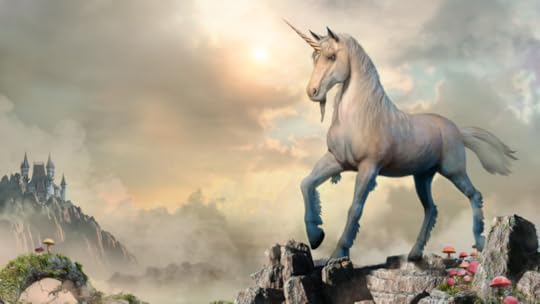
The unicorn is a legendary creature that has been described since antiquity as a beast with a single large, pointed, spiraling horn projecting from its forehead. It appeared in early Mesopotamian artworks and was referred to in ancient myths of India, China, and Greece. Those who drank from its horn were thought to be protected from epilepsy and poison. But what inspired this beautiful myth?
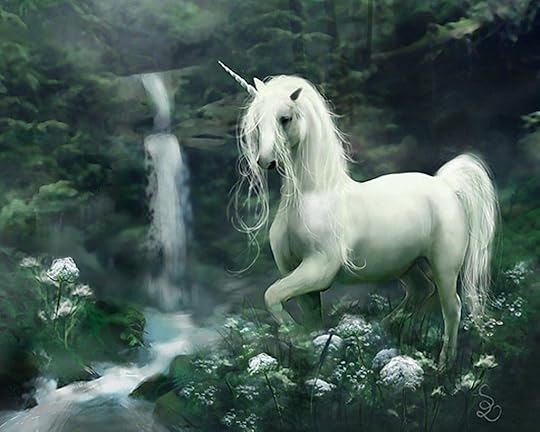
Biblical passages refer to a strong and splendid horned animal called re’em. This word was translated into “unicorn” meaning single horn or wild ox. The unicorn was interpreted allegorically in the early Christian church. The unicorn was considered a strong, fierce animal that could only be caught if a virgin maiden was placed before it. The unicorn would be attracted the woman, who would then suckle the animal and lead it to the king. Medieval writers likened this to the virgin birth of Christ.
If we look as the different translations of the word re’em. We can start to see where the myth began. One translation of Hebrew word re’em is rhinoceros.
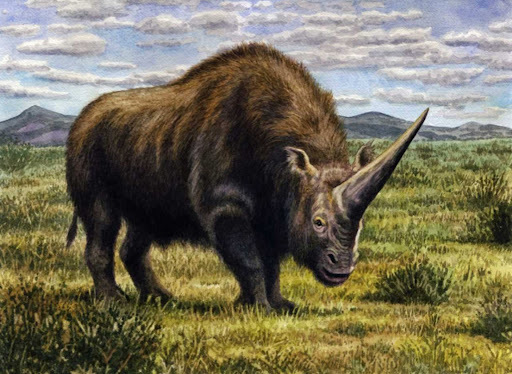
Early paintings and writings of the unicorn talk of a large, broad backed beast with a horn in the middle of its forehead. This is a far cry from the gracile beasts we think of them today. However, the skeleton of an extinct rhino called Elasmotherium could easily have been the inspiration for the ancient unicorn.
Elasmotherium lived through the last Ice Age. Its remains are found throughout China, the Caucasus, and Central Asia – where many of these myths originated. It was the size of a mammoth and had a large single, thick horn on its forehead. This large creature was herbivorous.
Today, people in Asian cultures use rhino horns for a number of medicinal purposes, including treating hangovers, aphrodisiacs, and even honoring terminally ill relatives. The properties of the rhino horn have gained almost magical properties. It would stand to reason that this tradition began much earlier when their rhinos were called unicorns.
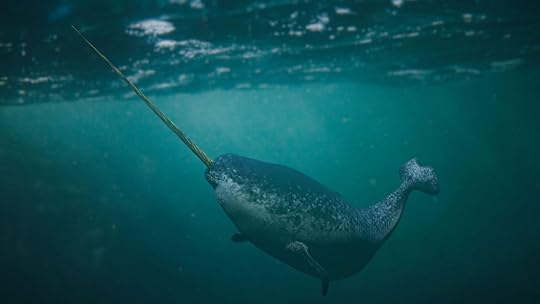
Another animal that is commonly attributed with the creation of the unicorn myth is the narwhal. Narwhals are medium-sized toothed whales that possess a large protruding canine tooth or “tusk.”
It lives year-round in the Arctic waters around Greenland, Canada, and Russia. The scientific name of the narwhal is Monodon monoceros meaning One-tooth One-horn. The common name is derived from the mottled coloring; Narwhal meaning “corpse whale.”
The long tusk projects from the left side of the upper jaw and forms a left-handed helix spiral. It can grow up to 3 m. This tusk is hollow and can weigh up to 10 kg. While the purpose of the tusk today is not known, it is speculated that is was used for mating displays and to create a nonviolent assessment of hierarchical status. In 2006, narwhals were also seen tapping and stunning cod before feeding on them.
Quacks in Medieval times up through the 1900’s would grind up narwhal tusks claiming it had the magical properties of unicorns. It was used to neutralize poison and cure depression. Vikings and other traders were able to sell them for many times their weight in gold. This contributed to their threatened status until 1996. Now, their population is estimated to be around 170,000 animals world wide and are classified as near threatened.
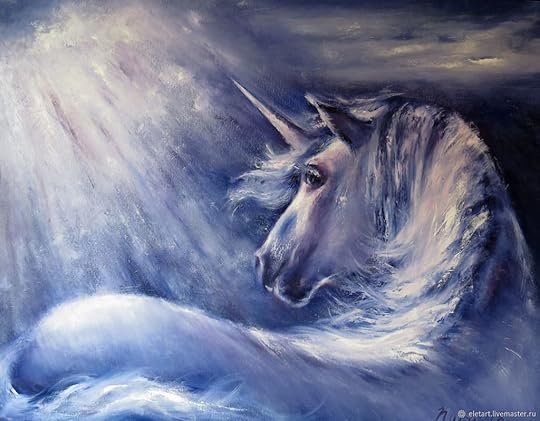
Unicorns are a beautiful myth. Their supposed magical properties have caused real life repercussions to two different groups of animals looking for its elusive magical power. These animals are as fascinating and magical as the unicorn. We need to work together to keep them from turning into their own myth.
Sources:
Lowry, L; Laidre, K; Reeves, R (2017). “Monodon monoceros“. IUCN Red List of Threatened Species. 2017.
Linnaeus, C (1758). Systema naturae per regna tria naturae, secundum classes, ordines, genera, species, cum characteribus, differentiis, synonymis, locis.
Heide-Jørgensen, M. P. & Laidre, K. L. (2006). Greenland’s Winter Whales: The beluga, the narwhal and the bowhead whale. Ilinniusiorfik Undervisningsmiddelforlag, Nuuk, Greenland.
Fischer, G. (1809). “Memoires de la Société Impériale des Naturalistes de Moscou”. Tome II. Moscou: Imprimerie de l’Université Impériale: 255.
Schvyreva, A.K. (August 2015). “On the importance of the representatives of the genus Elasmotherium (Rhinocerotidae, Mammalia) in the biochronology of the Pleistocene of Eastern Europe”. Quaternary International. 379: 128–134.
Kosintsev, Pavel; et al. (2019). “Evolution and extinction of the giant rhinoceros Elasmotherium sibiricum sheds light on late Quaternary megafaunal extinctions”. Nature Ecology and Evolution. 3 (1): 31–38.
“Numbers 23:22 – Bible Gateway”. http://www.biblegateway.com.
September 20, 2021
Mermaids

Since man started exploring the ocean, stories of fantastical creatures have come back with them. One in particular has become prevalent. This story spoke of a beautiful half-woman, half-fish who could lure men into the sea with her enchanting songs. But is she real?
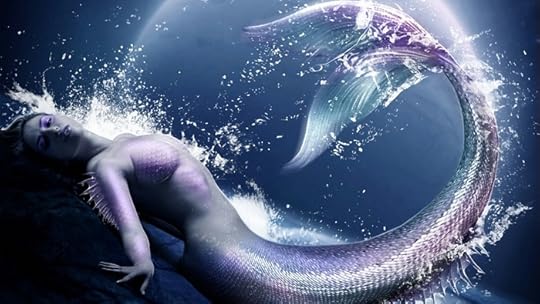
Mermaids appear in the folklore of many cultures worldwide, including Europe, Asia, and Africa. The word mermaid is a compound of the Old English mere meaning sea and maid.
The mythos has been around since the 4th century BCE. It was likely in ancient Syria with the goddess Atargatis, who watched over the fertility and well being of her people. Roman naturalist Pliny the Elder also wrote of nereids – who found a “considerable number of them dead upon the shore.” He describes a half-human, half-fish wish rough scales. But what was he looking at?
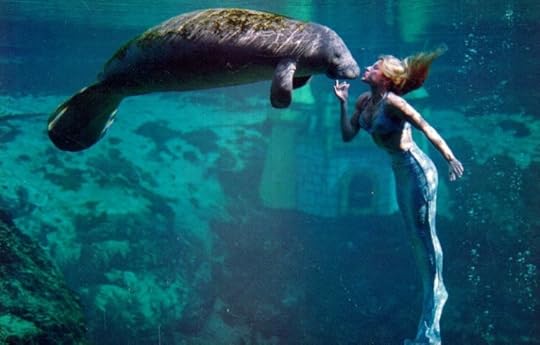
Many researchers attribute the myth of the mermaid to the sea mammals dugongs and manatees. Their scientific name is even Sirenia – further linking the idea.
These animals evolved over 60 million years ago. They are often covered in a course hair, even though they look smooth. Manatees are considered solitary creatures except when they group to breed. The calf then stays with the mother for over a year.
In 1492, Christopher Columbus even made this mistake. He claimed to have a mermaid sighting. It was actually the first written record of manatees in North America. It is strange to think that these slow moving sea cows could be mistaken for a fish-tailed beauty.
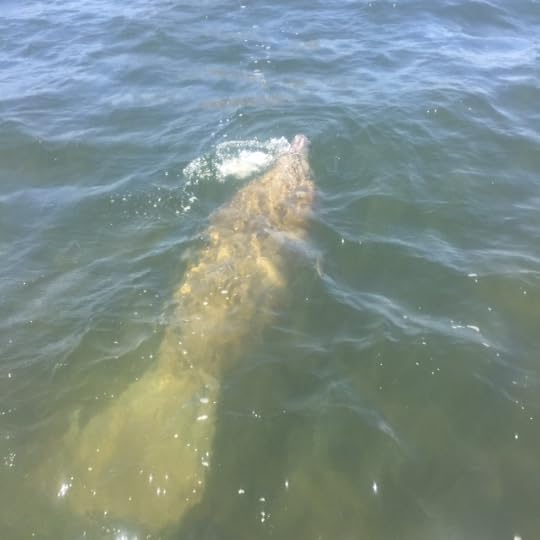
If you were to see a manatee swimming in the distance, it could possibly be mistaken for a human-fish hybrid. These creatures are also known for their melodic communication between groups. This would fuel the songs in the distance luring men to their deaths.
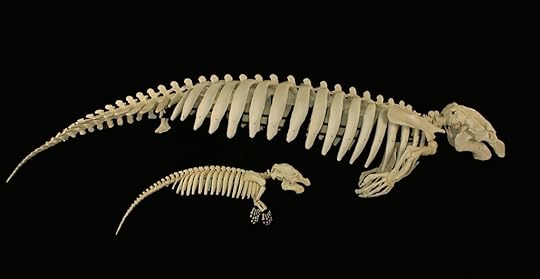
Also if you were to just find a manatee skeleton (without the head), the creature looks like some strange human-fish hybrid. Pliny the Elder describes several creatures that washed on shore. It is possible that several decaying bodies of manatees washed ashore and based on his description the myth of the mermaid circulated the world. These strange creatures could have easily led land starved sailors to believe that a mysterious woman was calling to them.
Sources:
Best, Robin (1984). Macdonald, D. (ed.). The Encyclopedia of Mammals. New York: Facts on File.
West Indian Manatee Facts and Pictures – National Geographic Kids
https://ocean.si.edu/ocean-life/marine-mammals/mermaids-manatees-myth-and-reality
https://www.wired.com/2014/10/fantastically-wrong-strange-murderous-sometimes-sexy-history-mermaid/
“Mermaid”. Online Etymology Dictionary.
“Atargatis, the Phoenician Great Goddess-Dea Syria Derketo Derceto mermaid goddess fish goddess water goddess canaanite goddess syrian goddess”. Thaliatook.com.
September 13, 2021
The Basilisk
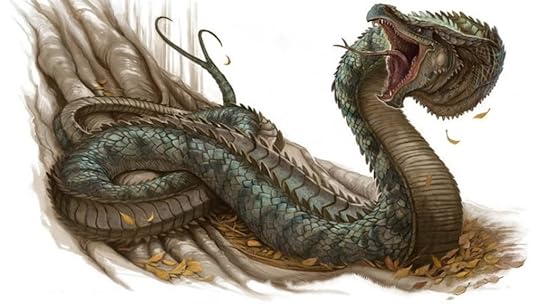
In Hellenic and Roman legend, a basilisk was a serpent-like creature capable of destroying other creatures with its deadly stare. It is said to be so venomous, it leaves trail of venom in its wake. But what inspired this great creature?
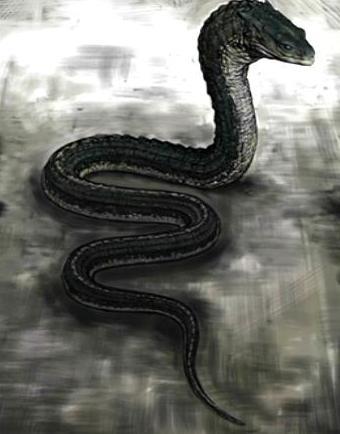
The Basilisk is known as the “King of Serpents.” In legend, it is a snake reported to reach gigantic size and live hundreds of years. The creature was born from a chicken’s egg hatched beneath a toad. Basilisks have deadly venom and fangs, and a murderous stare. Basilisks flees only from the crowing of the rooster, which is fatal to it.
The name basilisk comes from the Greek word basiliskos meaning “little king.” The animal is called “king” because it is reputed to have a crown-shaped crest on its head. In Medieval Europe, descriptions of the creature took on features of a variety of snakes in the area. Some even reported that it could breathe fire, though that was later attributed to Cockatrices.
One of the earliest accounts of the basilisk comes from Pliny the Elder’s Natural History, written in 79 AD. He describes a creature which “all who behold its eyes, fall dead upon the spot.”
But where did this creature come from?
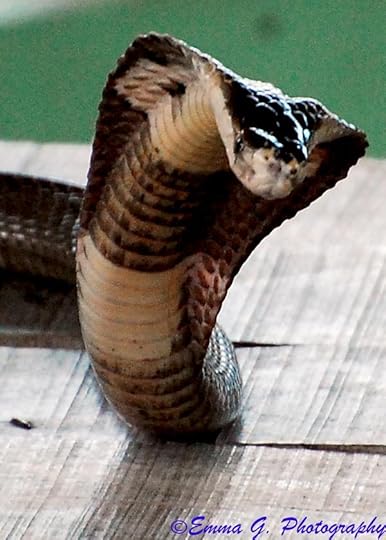
Some historians believe that the accounts and descriptions of cobras may have given rise to the legend of the Basilisk. Cobras can maintain an upright posture and are often killed by the weasel-like mongoose. King cobras also have the crested head. Spitting cobras can often incapacitate their prey from a distance and entrance their prey by staring at them in the eyes.
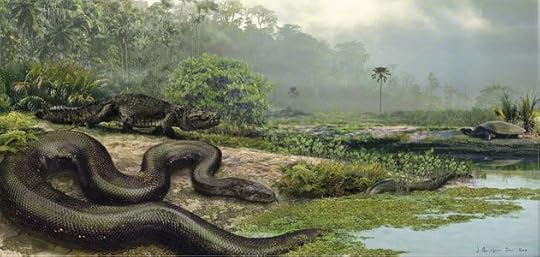
Other historians believe that the legends were derived from the bones of ancient, extinct snakes such as the Titanoboa. The Titanoboa is a genus of snakes that lived in what is now South America. They lived during the Mid-Late Paleocene (~60 – 58 million years ago). Titanoboa is considered to be the largest snake to have ever lived.
This animal could grow up to 12.8 m and weigh over 1,000 kg! It lived alongside ancestors of crocodiles and large turtles in swampy landscapes.
When Titanoboa lived, the Earth was much warmer than it is today, allowing these cold-blooded snakes to attain larger sizes.
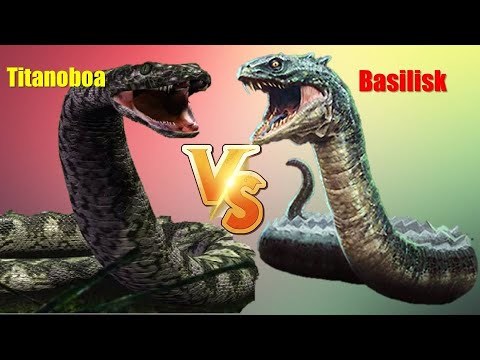
The Titanoboa has many similar characteristics as what the fabled Basilisk boasts. Like the Basilisk, the Titanoboa is very large and has big fangs. Scientists believe that the Titanoboa is more closely related to constrictors today, meaning that it would not be venomous. However, if ancient people only found their bones, they could have attributed venom to the animal based on other snakes found in their environment. Much like the Basilisk, the Titanoboa would have had large eyes, which may scare prey into freezing, like cobras do.
All in all, both creatures are fascinating. It is interesting to see how the skeleton of the Titanoboa could influence the myth of the Basilisk!
Sources:
Head et al., 2013
Makarieva et al., 2005
Pliny the Elder, Natural History.
Peter Costello (1979). The Magic Zoo: The Natural History of Fabulous Animals. Sphere Ltd.
September 1, 2021
Zazzle Store Now Open!
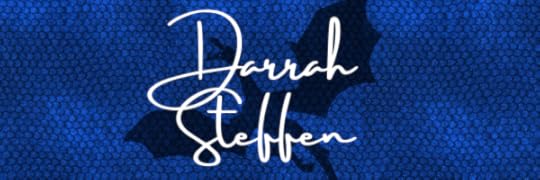
I have now opened a Zazzle store with exclusive merchandise for my book “Rise of the Dragon Queen” and other fun items! Be sure to go check it out!
Zazzle storeAugust 30, 2021
Cyclops
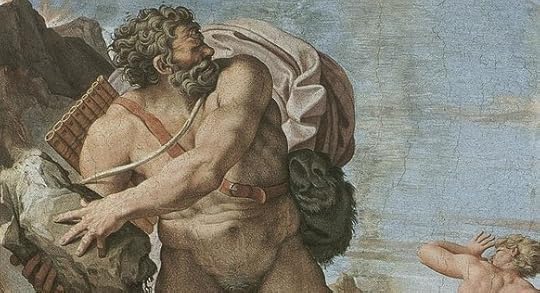
A cyclops is described in Greek legend as one of several one-eyed giants. In Homer, the Cyclops were cannibalistic monsters. Yet they are all defined by the large single eye that is centered in the center of the creature’s face and gigantic size. According to legend, the Cyclops had only one eye after making a deal with Hades in which they traded their eye for the ability to see the future. So, what sparked the myth?
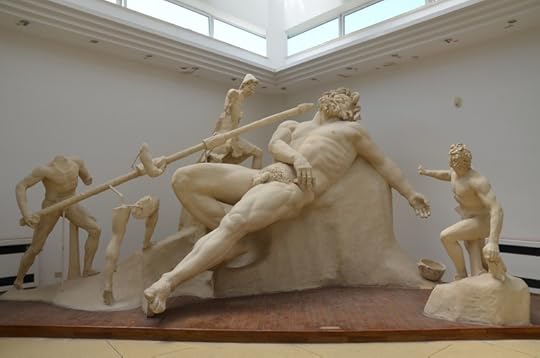
The name Cyclopes comes from the Greek work Kuklos and ops meaning circle- eyes. The name is a literal descriptor of the creature as Cyclops tend to have a single circle-shaped eye in the center of their foreheads.
The first recorded occurrence of the Cyclops is during the works of Hesiod and Homer in the 7th century BCE. The creatures worked with Zeus to defeat the Titans and install the gods in Olympus. These myths have been around for a long many generations. What was the inspiration behind them?
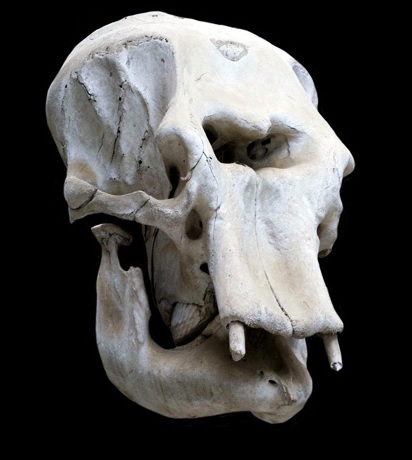
In 1914, paleontologist Othneio Abel proposed that the fossil skulls of Pleistocene dwarf elephants inspired the myth of cyclops. These extinct animals are commonly found in the coastal caves of Italy and Greece and may have given rise to the Polyphemus stories. These animals are believed to be descended from isolated populations of wooly mammoths that adapted to island life. The elephants went extinct around the end of the Ice Age, possibly due to climate change and human interaction.
The large, central nasal cavity where the trunk attaches in the skull may have been interpreted as a large single eye socket. If we look at contemporary sculptures of cyclops, they often depict the creature with the single eye in the center of the forehead but they also show two closed eyes below. This could further the myth of Cyclops as they traded the two normal eye sockets seen in the elephant skull for the central socket in the center of the forehead.
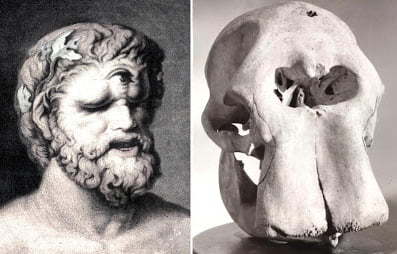
The size of the animal – even though it is a dwarf elephant – would be substantially larger than a human. Dwarf elephants ranged in size from 1.5 -2.5 meters in length. They lived across the Mediterranean islands and in now-underwater caves across the coast.
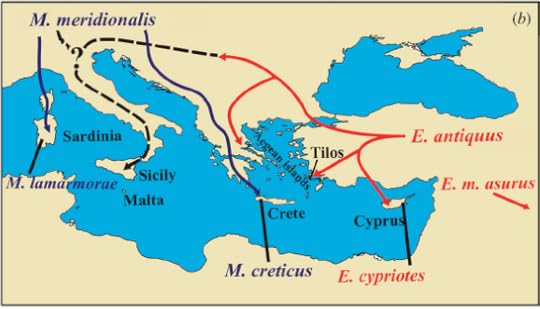
After these creatures went extinct, their bones remained. As the islands were colonized, people once again discovered the creatures. These interesting creatures sparked an equally interesting myth.
Sources:
Athanassiou, A.; Van der Geer, A. A. E.; Lyras, G. A. (2019). “Pleistocene insular Proboscidea of the Eastern Mediterranean: A review and update”. Quaternary Science Reviews. 218: 306–321.
Mayor, Adrienne (2011), The First Fossil Hunters: Dinosaurs, Mammoths, and Myth in Greek and Roman Times, Princeton University Press, 2011.
https://www.greek-gods.info/monsters/cyclopes/
https://education.seattlepi.com/character-traits-cyclops-book-the-odyssey-6629.html
August 16, 2021
The Loch Ness Monster
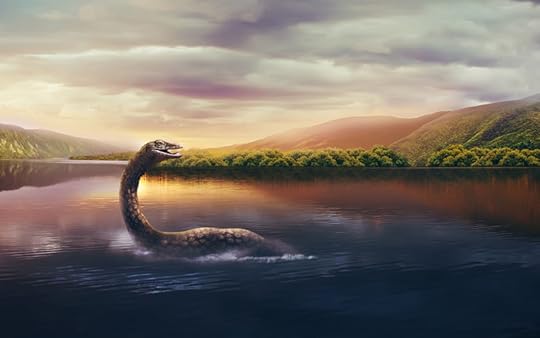
The Loch Ness Monster or Nessie is a creature of Scottish folklore that is said to inhabit Loch Ness in the Scottish Highlands. It is often described as having a long neck and humped body. It was brought to popular interest in the 1930s. The famous “Surgeon’s Photograph” was taken in 1934 furthering the mystery. But where did this creature come from?
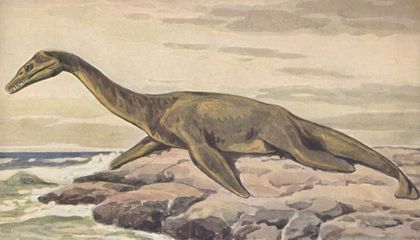
Reports of a monster inhabiting Loch Ness date back to ancient times. Local stone carvings by the ancient inhabitants of Scotland -the Picts – show a strange beast with flippers.
The first written account in the biography of St. Columba from 565 AD. According to the work, the monster bit a swimmer and was prepared to attack when Columba intervened. He ordered the beast away. It listened and was only seen occasionally from then on.
In 1933, the legend grew to a worldwide phenomenon. The road next to the Loch was finished. This offered an unobstructed view of the lake. Over time, reports of a dragon or beast were reported. People went sea serpent hunting. Footprints were reported from “a very powerful soft-footed animal about 6 meters long.”
Naturalists determined these to faked and made by umbrella stands with hippo feet on the end.
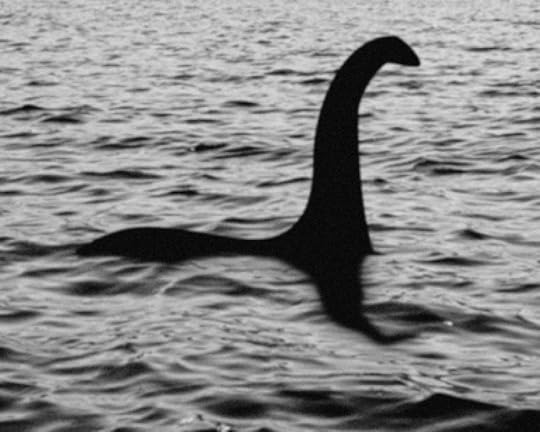
In 1934, English physician Robert Kenneth Wilson photographed the creature. This iconic image appeared in the Daily Mail sparking controversy. Many speculated that the creature was an animal that had been extinct for 65 million years.
This image was considered valid for 60 years. Though skeptics dismissed it as driftwood or an otter. The photo is often cropped in so that you cannot see the scale or surrounding environment.
In 1993, the photographed was analyzed. It was found that the object was being towed causing distortion in the ripples on the water. Also from the environment and ripples in the water, the object photographed was determined to only be about 2 to 3 ft long.
So what is this creature that many people believe the Loch Ness Monster is based on?
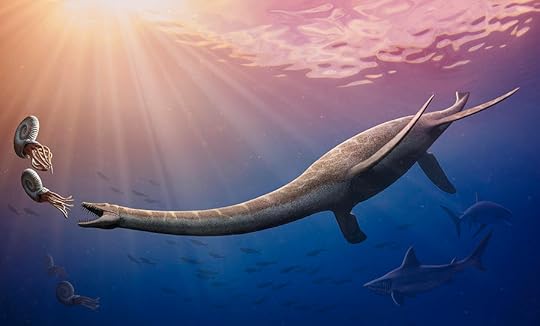
Plesiosaurs are a group of extinct, large marine reptile that can be found around the world. The Plesiosaurus lived in the early Jurassic period and is known from nearly complete skeletons found in chalk bluffs of England.
It is distinguished by its small head, long neck, broad turtle-like body, and pairs of paddles. These animals swam by flapping it paddles in the water in a style of underwater “flight.”
The flexible neck would have allowed the animal to swing its head from side to side through schools of fish to capture its prey using the sharp teeth in its jaws. With its long neck, it is also thought, the plesiosaur would hide its mass in the deep and reach into the schools with its small head to hunt, surprising its prey
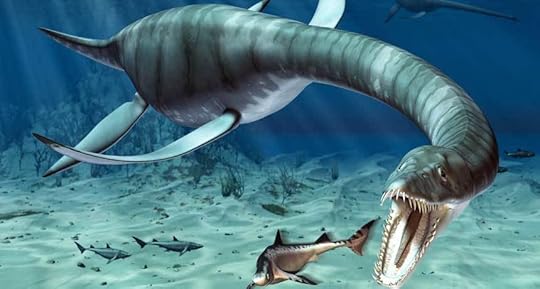
Late in their evolution, plesiosaurs were marked by great increases in size. For example, the North American Elasmosaurus grew up to 13 meters in length. These creatures went extinct with the dinosaurs at the end of the Cretaceous period.
It is unlikely that “Nessie” lives today or that a lone plesiosaur survives in the Loch. It simply is not large enough to sustain a creature of that scale. There would also have to be multiple breeding pairs to have continuous sightings over the years. If this were the case, we would have confirmation that the creatures were in fact living in the Loch.
It is most likely that these stories were passed down over time and through cultures. The Pict drawings may have been inspired by finding the Plesiosaur skeletons before it was officially named.
Sources:
https://www.britannica.com/animal/plesiosaur
“The Loch Ness Monster and the Surgeon’s Photo”. Museumofhoaxes.com.
https://www.britannica.com/topic/Loch-Ness-monster-legendary-creature
Carroll, Robert Todd (2011) [2003], The Skeptic’s Dictionary: A Collection of Strange Beliefs, Amusing Deceptions, and Dangerous Delusions, John Wiley & Sons, Inc., pp. 200–201
August 8, 2021
Werewolf
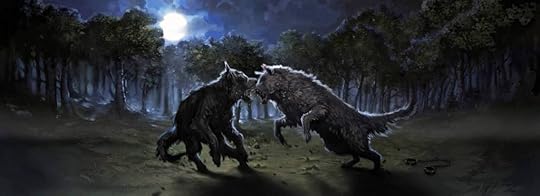
The werewolf is a widespread concept in European folklore. It is considered to be a human with the ability to shapeshift into a wolf or a hybrid creature. This is usually due to a curse or affliction associated with the full moon. But where did this idea come from?
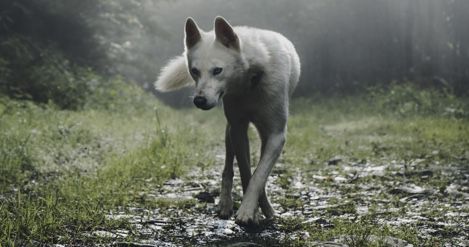
The word werewolf comes from the Old English word werwulf, meaning man wolf. The word does not appear in the lexicon until around the 15th century.
The term lycanthropy, referring to the ability to transform into a wolf and the act of doing so, comes from Ancient Greek. The word originally was used to describe a patient with ravenous appetite and other wolf-like qualities. It was not used to describe shapeshifting until around 1830.
The Slavic term vlko-dlak literally translates to “wolf-skin” paralleling the Norse term ulfhéðinn. These word may speak to the origins of the story of the werewolf, but was not used widely until the 1800’s.
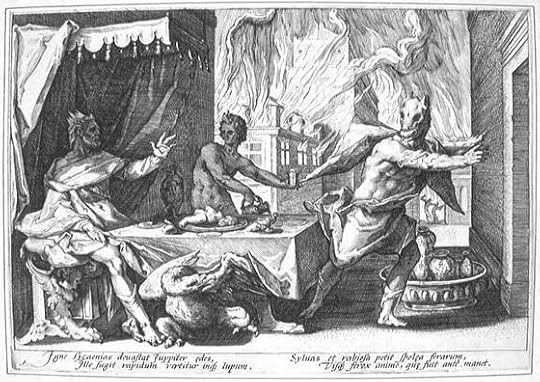 “Lycaon turned into a wolf”
“Lycaon turned into a wolf”The earliest surviving example of a man-to-wolf transformation is in “The Epic of Gilgamesh” from around 2,100 BC. And in texts from ancient Greece and Rome. These stories spoke of nomadic men who changed shapes to survive the harsh weather. Current historians believe that these nomadic tribes were using wolf skins to protect against the elements and called this a “transformation.”
The common idea of a werewolf became popular during the medieval period. It grew concurrently with the idea of witches. Trials of werewolves emerged in Switzerland in the early 15th century much like the witch trials.
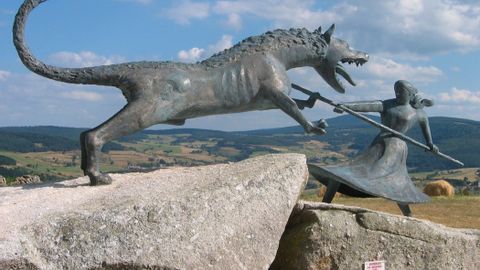 The Maid fighting the Beast of Gévaudan
The Maid fighting the Beast of GévaudanOne theory that popularized the idea of a werewolf was the attacks of Gévaudan in the mid 1700’s. A creature terrorized a small province in France. The attacks covered an area spanning 7,200 square kilometers. The monster was often described as a large wolf. Victims were killed by having their throats torn out.
By the time, the animal was killed there was an estimated 600 attacks, resulting in 500 deaths and 50 injuries. Many of the bodies were partially eaten.
Many modern scholars believe this to be the work of public hysteria combined with wolf attacks in the area. Wolf attack were common in the area especially as people pushed into their territory.
Other scholars have started to wonder if possibly there was a serial killer active in the area.
Many of the victims of the beast were young women and children. They were often found decapitated. Others were found with their clothing neatly folded next to their bodies. Hunters of this beast also reported that the beast was standing on its hind limbs and the bullets had no effect when they hit the creature.
The man who ended up killing the Beast of Gévaudan – Jean Chastel – is a prime suspect in the slayings. It is thought perhaps he trained packs of dogs to terrorize the countryside. The decapitation and clothing were a result of more nefarious purposes from the man.
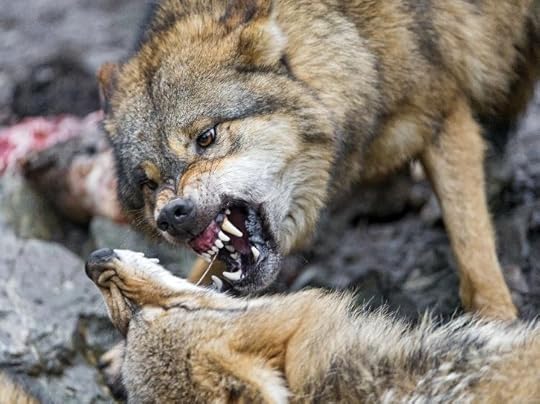
These accounts in Gévaudan are still fairly modern for the origin of the werewolf. While it may have helped popularize the mythology across Europe, the start of the myth has a more mundane origin.
Rabies is a fatal viral disease that can spread between animals and to people if they are scratched or bitten. In the United States, rabies is mostly found in bats, raccoon, skunks, and foxes. However, in many other countries, dogs still carry rabies. Most rabies deaths in people are caused by dog bites.
The rabies virus infects the central nervous system, causing disease in the brain, and ultimately death.
Humans affected by this disease are often afflicted with fever, headaches, nausea, and changes in appetite. As the symptoms progress, they can become aggressive, confused, hallucinate, have seizures, and be extremely sensitive to sound and light. Those afflicted also produce excess saliva and have difficulty swallowing. This produces the foaming of the mouth effect. As well as the fear of water due to thoughts of choking.
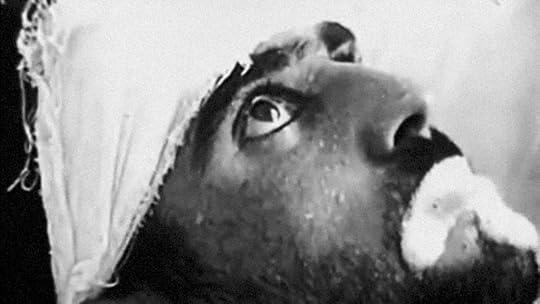 Man afflicted with rabies
Man afflicted with rabiesIf we think about behaviors commonly associated with Werewolf mythos, we can see how these can fall in line with a person afflicted by rabies.
The curse of the werewolf is transferred through a scratch or bite. This is also true for rabies. Rabies is most commonly transmitted though bites but can also spread if saliva enters an open wound on a person. The association with biting and scratching was most likely associated with animal attacks – furthering the werewolf legend.
Werewolves are also described as animalistic and aggressive. They are seen as monsters not in control of themselves. In many stories, the human side becomes dormant. They are not conscious of what occurs during their transformation. This can be described by the neurological changes occurring within the afflicted. Aggression is common with rabies as well as confusion. The afflicted may feel out of control or even hallucinate a danger they are responding to. This can explain some of the erratic behavior described in werewolf lore.
Werewolves are said to shift during the full moon, but this is not always the case. If we look at the final symptom of rabies we may see a reasoning for this part of the lore. Rabies causes an acute sensitivity to light and sound. Those afflicted with the virus would have a difficult time adjusting to daylight brightness and sounds of cities. This would push them into an alternative lifestyle, living in isolated areas during the night.
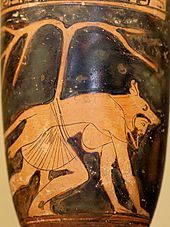 Werewolf on Vase, 460 BC
Werewolf on Vase, 460 BC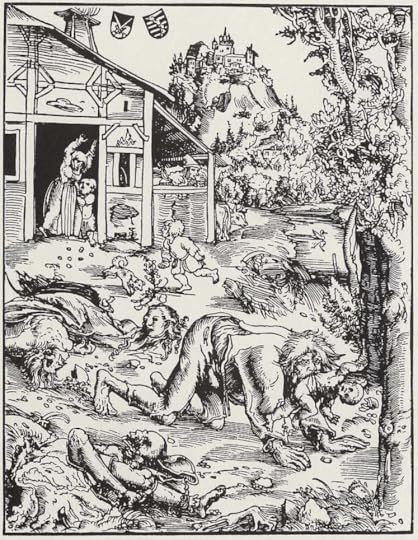 Woodcut of Werewolf attack, 1512
Woodcut of Werewolf attack, 1512
If we look at all of the writings that influenced the legends, we can see how the legend as we know it today came together. Animal attacks led to people being infected with rabies. The rabies rapidly altered the way the infected acted. Nomadic people wandered Europe, often using wolf skins for protection from the elements. These people would have been more susceptible to animal attacks as they were moving through animal territories and had no permanent fortifications.
Finally, let us look at one last part of the werewolf lore. When these creatures are killed, werewolves are said to revert back to their human form, exposing the beast as neighbors and friends. This further indicates that the creature that was being hunted was a man infected by rabies. Once the hunt was over, the people realized they had killed someone they knew and loved. It is easier to have a monster to blame it on.
Sources:
“Werwolf” in Grimm, Deutsches Wörterbuch. “online version”
Rose, C. (2000). Giants, Monsters & Dragons: An Encyclopedia of Folklore, Legend and Myth. New York: Norton. p. 230.
Eisler, Robert (1948). Man Into Wolf – An Anthropological Interpretation of Sadism, Masochism, and Lycanthropy.
CDC on Rabies
https://science.howstuffworks.com/science-vs-myth/strange-creatures/werewolf.htm
Smith, Jay M. (2011). Monsters of the Gévaudan. Cambridge, Massachusetts: Harvard University Press.
Canepa, Nancy L. (1997). Out of the Woods: The Origins of the Literary Fairy Tale in Italy and France. Wayne State University Press
August 2, 2021
Anniversary Traditions

My husband and I recently celebrated our fourth wedding anniversary. We did all the classic things. We had a nice dinner. We went to a show. It was a nice evening. Talking with my uncle, he asked us what four years was. We discussed what it all meant and how it started. I thought I would share it with you.
The names of some anniversaries provide guidance for traditional gifts given. These gifts can vary in different countries, but many such as the 5, 10, and 15 year milestones are the same throughout.
It is believed this tradition may have originated in medieval Germany, where if a married couple lived to see their 25th wedding anniversary their neighbors presented them with a silver wreath to celebrate their good fortune. Upon the 50th, they would receive a wreath of gold. Over time, the symbology expanded and gifts were assigned that had direct connections to each stage of married life.
1st Anniversary – Paper
Paper is given the first year because it is fragile, like the first stages of marriage. It also represents a new beginning.
2nd Anniversary – Cotton
The woven threads symbolize how your lives have become interconnected and learn to become flexible.
3rd Anniversary – Leather
Leather symbolized shelter and security. It represents the home you build together. It is also durable, supple, and can change over time. There maybe imperfections, but that is what makes it beautiful.
4th Anniversary – Fruit or Flowers
This symbolizes your relationship blooming, with deep nourishment and constant renewal.
5th Anniversary – Wood
By the fifth year, you have put down roots in the relationship, much like a tree. Together you can endure anything.
6th Anniversary – Iron or Sugar
Iron represents the strength of your relationship. Sugar has taken over the older tradition in recent years. This represents the sweetness of your relationship and the feeling of when you first met.
7th Anniversary – Copper or Wool
Both of these symbols represent the warmth of your relationship. They represent safety, warmth and comfort, whether it is through copper mug or a warm woolen blanket.
8th Anniversary – Bronze or Pottery
Like many of the metals, bronze symbolizes the strength of your relationship. Pottery symbolizes the your relationship solidifying.
9th Anniversary – Willow
Willow represents nature and flexibility. It shows how being adaptable can lead to harmony. (Though we got our Willow gift a few years early!)
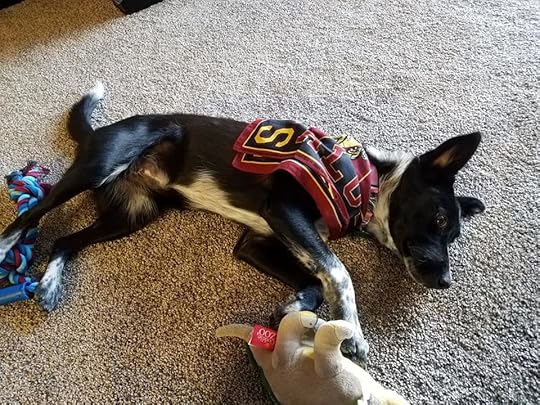 This is our pup, Willow. We adopted her in August 2019.
This is our pup, Willow. We adopted her in August 2019.10th Anniversary – Tin
Tin is typically used to preserve something precious and protect its contents from outside elements. Tin won’t rust, meaning it will never wear down. This represents how your marriage will endure.

There are many others and variations from the original list. The origins of the current gift conventions date to 1937. Until then only the major hallmarks had associated symbols. The American National Retail Jeweler Association introduced an expanded list to what we know today. It included a gift for every year until the 25th anniversary and every fifth year after that.
Sources:
https://www.refinery29.com/en-us/traditional-anniversary-gifts-guide
https://www.theknot.com/content/milestone-anniversary-gift-ideas
July 19, 2021
Bunyip
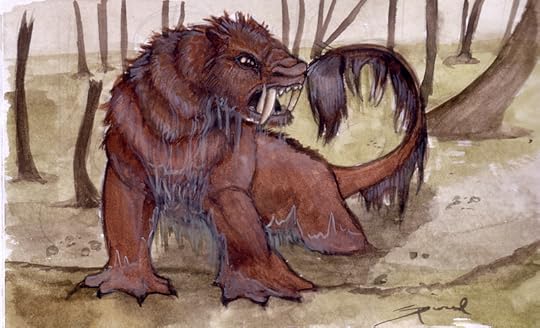
The Bunyip is a creature from Australian Aboriginal mythology, said to lurk in swamps and riverbeds. Over the years, the description has varied wildly from a water spirit in the form of a starfish to a large black animal like a seal with fangs. But where did this creature come from?
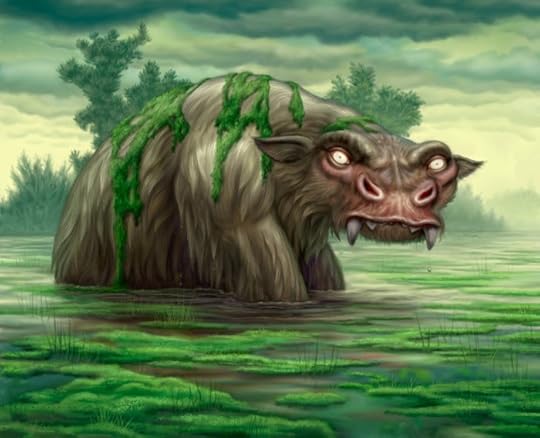
The bunyip was part of traditional Aboriginal beliefs and stories throughout Australia, though it changes by region. The word bunyip most commonly translates to “devil” or “evil spirit.”
Images of these strange beasts have appeared in Aboriginal drawings across the continent. Europeans recorded various written accounts of the animal as they began settling the country.
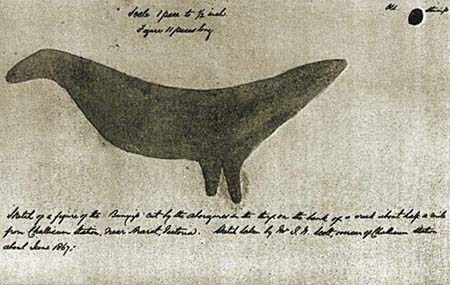 Drawing of the Callicum Bunyip
Drawing of the Callicum BunyipThe Challicum Bunyip is considered to be the outline of the animal carved by the native people into the banks of Fiery Creek. Reports say in 1851, the bunyip came from the water and killed an Aboriginal man. The community then speared the creature. The outline no longer remains.
Throughout the Victorian era, sightings of the creature increased. The creature was described one of two ways. Most stated the Bunyip resembled seals or dogs around 6 feet long with shaggy brown coats. The others described the creature as being up to 15 feet long, with black fur, small tusks, and a long neck like an emu.
The Bunyip was thought to be able to swim swiftly and see in the dark.
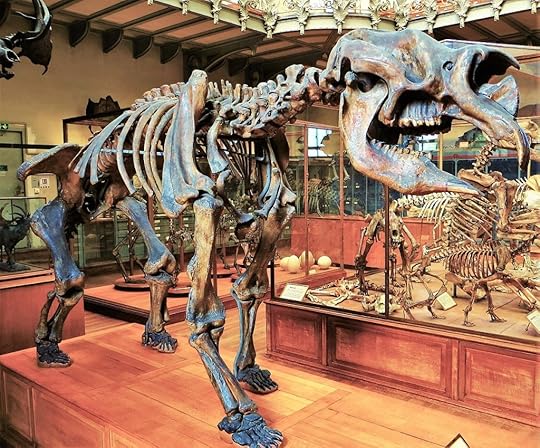 Diprotodon skeleton on display at the Australian Museum
Diprotodon skeleton on display at the Australian MuseumWhile many people think that the Bunyip was created from seals making their way up the riverway, others believe that the bunyip may be cultural memory of an extinct marsupial called the Diprotodon.
This connection was originally made by Dr. George Bennett of the Australian Museum in 1871. In the 1990’s, paleontologist Pat Vickers-Rich suggested the legends perhaps stemmed from an acquaintance with prehistoric skeletons or even the living creatures.
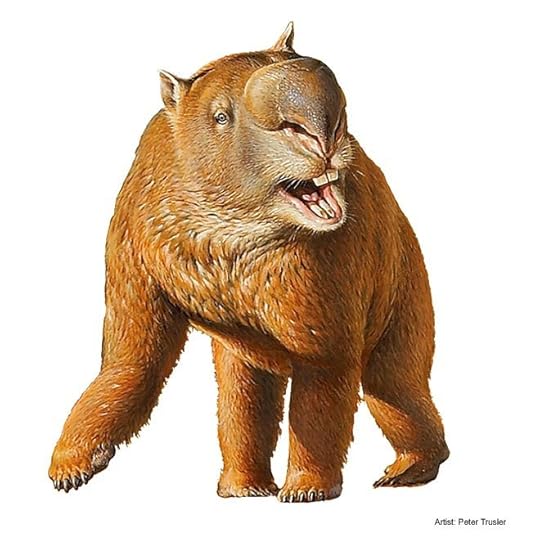 Artists depiction of Diprotodon
Artists depiction of DiprotodonDiprotodon is an extinct genus of marsupials native to Australia, thriving during the Pleistocene (Ice Age). It is considered the largest marsupial to ever have existed. Diprotodon went extinct some 44,000 years ago after the initial settlement of the continent. Scientists debate whether human and climatic factors contributed to their extinction.
The creature is known from sites across mainland Australia. The largest specimens were hippo-sized, standing 6.5 ft tall and weighting over 3 tons.
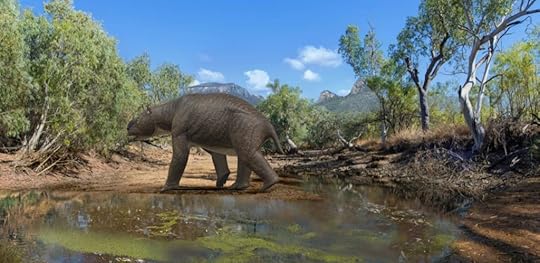 Diprotodon at a watering hole
Diprotodon at a watering holeDiprotodon is usually compared to a large wombat. In fact it is considered a distant relative of wombats and koalas. Like its relatives, it had two forward-projection teeth that stuck from its mouth like tusks. It had a large skull with an unusually large nasal. This suggested either a large nose or a tapir-like trunk. It was quadrupedal and browsed plant material.
The creature was known from across the continent, but could be coastal regions. While the Diprotodon had the anatomy to feed on shrubs and forbs, others in the family could be found near rivers and the coast. These animals could be found basking in watering holes – much like elephants.
Unlike elephants, marsupials do not move in herds. It is likely that lone individuals or small groups could be found near waterholes.
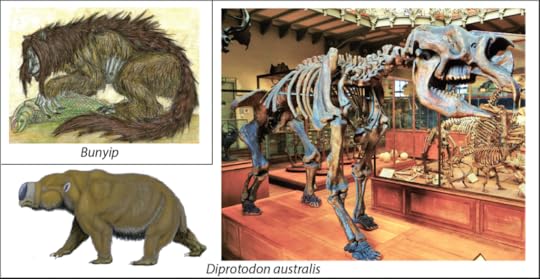 Bunyip compared to Diprotodon
Bunyip compared to DiprotodonThe Aboriginal peoples and the Diprotodon would have crossed paths. Australia was originally settled approximately 58,000 years ago. By that time, the Diprotodon would have established itself into the wilds of the continent. As the Aboriginal people spread, they would have come into contact with this ferocious looking beast. Stories spread between tribes sparking the idea of this monster. As time passed, the legend of the Bunyip was passed down through generations with its origins murky.
Sources:
https://australian.museum/learn/australia-over-time/extinct-animals/diprotodon-optatum/
https://www.britannica.com/animal/Diprotodon
http://anomalyinfo.com/Stories/1851-pre-challicum-bunyip
Holden, Robert (2001), Bunyips: Australia’s folklore of fear, National Library of Australia.
Eberhart, George M. (2002). Mysterious Creatures: A Guide to Cryptozoology. pp. 74–77.
Price, G.J. (June 2008). “Taxonomy and palaeobiology of the largest-ever marsupial, Diprotodon Owen, 1838 (Diprotodontidae, Marsupialia)”. Zoological Journal of the Linnean Society. 153 (2): 369–397.
Roberts, R.G.; Flannery, T.F.; Ayliffe, L.K.; Yoshida, H.; Olley, J.M.; Prideaux, G.J.; et al. (8 June 2001). “New ages for the last Australian megafauna: Continent-wide extinction about 46,000 years ago” (PDF). Science. 292 (5523): 1888–1892.
July 13, 2021
Birthday Sale!

It’s my birthday! I want to celebrate with all of you! You can now buy my book for the reduced price of $13.50 and the ebook for $2.99!



